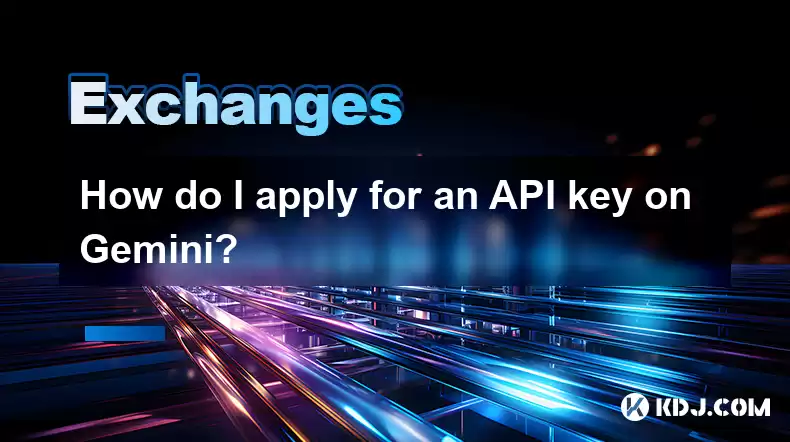-
 bitcoin
bitcoin $87959.907984 USD
1.34% -
 ethereum
ethereum $2920.497338 USD
3.04% -
 tether
tether $0.999775 USD
0.00% -
 xrp
xrp $2.237324 USD
8.12% -
 bnb
bnb $860.243768 USD
0.90% -
 solana
solana $138.089498 USD
5.43% -
 usd-coin
usd-coin $0.999807 USD
0.01% -
 tron
tron $0.272801 USD
-1.53% -
 dogecoin
dogecoin $0.150904 USD
2.96% -
 cardano
cardano $0.421635 USD
1.97% -
 hyperliquid
hyperliquid $32.152445 USD
2.23% -
 bitcoin-cash
bitcoin-cash $533.301069 USD
-1.94% -
 chainlink
chainlink $12.953417 USD
2.68% -
 unus-sed-leo
unus-sed-leo $9.535951 USD
0.73% -
 zcash
zcash $521.483386 USD
-2.87%
How do I apply for an API key on Gemini?
Applying for a Gemini API key is simple: visit the site, log in, navigate to the API section, create and configure your key, then confirm with a verification code.
Apr 06, 2025 at 04:14 pm

Applying for an API key on Gemini is a straightforward process that allows you to interact with the Gemini exchange programmatically. This guide will walk you through the steps required to obtain your API key, ensuring you can start using Gemini's API for trading, data retrieval, and other functionalities.
Accessing the Gemini Website
To begin the process of applying for an API key, you need to visit the Gemini website. Navigate to the Gemini homepage by entering www.gemini.com in your web browser. Once on the homepage, ensure you are logged into your Gemini account. If you do not have an account, you will need to create one before proceeding.
Navigating to the API Section
After logging in, locate the API section on the Gemini platform. This can typically be found in the account settings or under a dedicated API tab. To find it, follow these steps:
- Click on your profile icon or username in the top right corner of the Gemini website.
- From the dropdown menu, select Settings.
- In the settings menu, look for and click on the API tab.
Creating a New API Key
Once you are in the API section, you will see an option to create a new API key. Click on the Create New API Key button. You will be prompted to enter a name for your API key, which helps you identify it later. Choose a name that is meaningful to you, such as 'TradingBot' or 'DataAnalysis'.
Configuring API Key Permissions
After naming your API key, you will need to configure its permissions. Gemini allows you to set specific permissions for each API key, ensuring you can control what actions the key can perform. You will see a list of permissions such as:
- Read
- Trade
- Withdraw
- Fund Management
Select the permissions that align with your intended use of the API key. For example, if you only need to retrieve data, you might only select the Read permission. If you plan to execute trades, you will need to select the Trade permission as well.
Confirming and Activating the API Key
Once you have set the permissions, you will need to confirm the creation of the API key. Gemini will prompt you to enter a verification code sent to your registered email address or phone number. Enter the code to proceed.
After verification, your API key will be generated. You will see two important pieces of information:
- API Key: This is the public key that you will use to identify your account when making API requests.
- Secret Key: This is the private key that you must keep secure. It is used to sign your API requests and should never be shared.
Make sure to copy and securely store both the API Key and the Secret Key. Gemini will only display the Secret Key once, so it is crucial to save it immediately.
Using Your API Key
With your API key in hand, you can now start using it to interact with Gemini's API. You will need to include your API Key and Secret Key in your API requests, typically through headers or query parameters, depending on the API endpoint you are using.
For example, if you are using a programming language like Python to interact with the Gemini API, you might use a library like requests to send authenticated requests. Here is a basic example of how you might structure an API call:
import requests
api_key = 'YOUR_API_KEY'api_secret = 'YOUR_SECRET_KEY'
Example API endpoint
url = 'https://api.gemini.com/v1/pubticker/btcusd'
Headers for authentication
headers = {
'X-GEMINI-APIKEY': api_key,
'X-GEMINI-PAYLOAD': 'YOUR_PAYLOAD',
'X-GEMINI-SIGNATURE': 'YOUR_SIGNATURE'
}
response = requests.get(url, headers=headers)
print(response.json())
Remember to replace YOUR_API_KEY, YOUR_SECRET_KEY, YOUR_PAYLOAD, and YOUR_SIGNATURE with the actual values and calculations required for your specific API request.
Managing Your API Keys
It is important to manage your API keys effectively. Gemini provides options to view, edit, and delete your API keys. To manage your keys:
- Return to the API section in your Gemini account settings.
- You will see a list of all your API keys, along with their names and permissions.
- To edit a key, click on the key and adjust its permissions or name as needed.
- To delete a key, click on the key and select the option to delete it. Be cautious, as this action is irreversible.
Security Considerations
When using API keys, security is paramount. Here are some best practices to keep in mind:
- Never share your Secret Key: Treat your Secret Key like a password. Do not share it with anyone or store it in plain text.
- Use strong authentication: Enable two-factor authentication (2FA) on your Gemini account to add an extra layer of security.
- Monitor your API activity: Regularly check your API key usage and look for any suspicious activity.
- Limit permissions: Only grant the permissions necessary for your use case to minimize potential risks.
Frequently Asked Questions
Q: Can I have multiple API keys on Gemini?Yes, you can create multiple API keys on Gemini. Each key can have different permissions, allowing you to use them for different purposes or applications.
Q: What should I do if I lose my Secret Key?If you lose your Secret Key, you will need to delete the associated API key and create a new one. Gemini will not be able to retrieve or reset your Secret Key.
Q: How often should I rotate my API keys?It is a good practice to rotate your API keys periodically, such as every few months, to enhance security. This involves deleting old keys and creating new ones with updated permissions.
Q: Can I use my API key to withdraw funds from Gemini?Yes, if you have granted the Withdraw permission to your API key, you can use it to initiate withdrawals. However, be extremely cautious with this permission and ensure your Secret Key is well-protected.
Disclaimer:info@kdj.com
The information provided is not trading advice. kdj.com does not assume any responsibility for any investments made based on the information provided in this article. Cryptocurrencies are highly volatile and it is highly recommended that you invest with caution after thorough research!
If you believe that the content used on this website infringes your copyright, please contact us immediately (info@kdj.com) and we will delete it promptly.
- 1inch and Blockscan Revolutionize Cross-Chain Transactions with New Explorer
- 2025-12-16 01:10:02
- Solana's Shifting Narrative: Blockchain Dominance Meets Evolving Investor Focus, Analyzed by CoinGecko Data
- 2025-12-16 01:25:01
- Ueda's Bold Hand: Bank of Japan Charts New Course with Tightening Policy
- 2025-12-16 01:25:01
- Wet Token Splashes onto the Scene with Astounding Price Increase in Cryptocurrency Market
- 2025-12-16 01:00:01
- Navigating the Crypto Currents: Ethereum, Solana, XRP, and the Ozak AI Surge
- 2025-12-16 01:20:01
- SBP Policy Rate Cut Sparks Outcry: Business Community Demands Deeper Cuts for Economic Revival
- 2025-12-16 01:20:01
Related knowledge

What does it mean to "Hedge" a position on Bybit and how do I do it?
Dec 11,2025 at 07:00pm
Understanding Position Hedging on Bybit1. Hedging on Bybit refers to opening opposing positions in the same trading pair to reduce exposure to adverse...

How to secure my Bybit account against phishing and scams?
Dec 12,2025 at 11:39am
Enable Two-Factor Authentication (2FA)1. Log in to your Bybit account and navigate to the Security Settings section. 2. Select Google Authenticator or...

What is the "Reduce-Only" option on Bybit and how does it prevent accidental orders?
Dec 15,2025 at 10:40am
Understanding Reduce-Only Mode1. Reduce-Only is a risk control feature on Bybit that restricts order execution to positions that only decrease or clos...

How to convert small balances ("dust") to another coin on Bybit?
Dec 07,2025 at 08:59pm
Understanding Dust Conversion on Bybit1. Dust refers to tiny, non-withdrawable balances of cryptocurrencies left in a user’s spot wallet after partial...

What are subaccounts on Bybit and why would I need to use one?
Dec 14,2025 at 06:00pm
Understanding Subaccounts on Bybit1. Subaccounts on Bybit are independent trading entities linked under a single master account, each with its own uni...

Why is the Bybit app not working or showing a connection error?
Dec 07,2025 at 06:00pm
Troubleshooting Network Configuration Issues1. The Bybit app relies heavily on stable internet connectivity to synchronize real-time market data and e...

What does it mean to "Hedge" a position on Bybit and how do I do it?
Dec 11,2025 at 07:00pm
Understanding Position Hedging on Bybit1. Hedging on Bybit refers to opening opposing positions in the same trading pair to reduce exposure to adverse...

How to secure my Bybit account against phishing and scams?
Dec 12,2025 at 11:39am
Enable Two-Factor Authentication (2FA)1. Log in to your Bybit account and navigate to the Security Settings section. 2. Select Google Authenticator or...

What is the "Reduce-Only" option on Bybit and how does it prevent accidental orders?
Dec 15,2025 at 10:40am
Understanding Reduce-Only Mode1. Reduce-Only is a risk control feature on Bybit that restricts order execution to positions that only decrease or clos...

How to convert small balances ("dust") to another coin on Bybit?
Dec 07,2025 at 08:59pm
Understanding Dust Conversion on Bybit1. Dust refers to tiny, non-withdrawable balances of cryptocurrencies left in a user’s spot wallet after partial...

What are subaccounts on Bybit and why would I need to use one?
Dec 14,2025 at 06:00pm
Understanding Subaccounts on Bybit1. Subaccounts on Bybit are independent trading entities linked under a single master account, each with its own uni...

Why is the Bybit app not working or showing a connection error?
Dec 07,2025 at 06:00pm
Troubleshooting Network Configuration Issues1. The Bybit app relies heavily on stable internet connectivity to synchronize real-time market data and e...
See all articles










































































